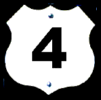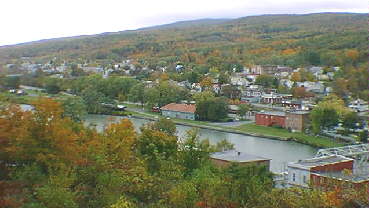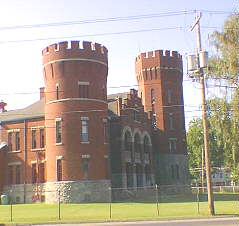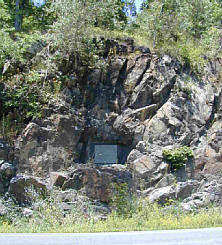SKENESBOROUGHTODAY'S WHITEHALL, NEW YORK |
 |
| US4 | NY5 | US7 | US9W | US20 | US60 | US202 | US221 | Canal |
SKENESBOROUGHTODAY'S WHITEHALL, NEW YORK |
 |

On the corner of Saunders and Main Streets is a park on the Champlain Canal. The canal connects Lake Champlain with the Hudson River at Fort Edward, an upcoming stop on this Revolutionary Day. Near the center of the park is a "Birthplace of the United States Navy" marker. Just down the road on the left is the Skenesborough Museum. Near the museum, there is a Whitehall Harbor marker.
Skenesborough Museum – The museum contains a model of Whitehall during the Revolutionary War Period and includes audio effects. The model shows a town centered around shipbuilding and a harbor full of ships.
|
|
|
|
|
Whitehall Whitehall was settled in 1759 at the southern end of Lake Champlain. Founded as the colonial town of Skenesboro by British Army Captain Philip Skene, this community became the first permanent settlement on Lake Champlain. An important center of maritime trade, Skene developed lake travel north to reach the West Indies via Quebec. On May 9, 1775, Skenesboro was captured by American forces in the first aggressive revolutionary war action in New York State. Skene's trading schooner became the first ship of the US Navy when it was taken to Crown Point armed and used under the leadership of Col. Benedict Arnold to capture a British ship renamed Enterprise on May 18, 1775. In 1776, Congress ordered General Philip Schuyler to construct a fleet of ships capable of countering an expected British invasion. This first US Naval fleet of thirteen ships added to the four already patrolling Lake Champlain was constructed during the summer of 1776. Led by Benedict Arnold, the action of this fleet at the battle of Vancour in October of that year caused a delaying action that ultimately saved the American Forces at Saratoga. This naval fleet was the only one to see active service in the Revolutionary War. |
|
|
|
|
|
|
|
|
|
Skene's Mills – The Lock 12 Marina is where the sawmills were located. The marina can be found by crossing the bridge over the canal and turning left onto North Williams Street. It is a few blocks up William Street. The Skene’s Mill marker is between the marina and the canal and can only be seen by parking at the marina.
|
|
Skene's Mills In this vicinity at Wood Creek Falls stood the Skenesboro mill that was used to saw plank for Benedict Arnold's 1776 Valcour fleet. |
 Naval
Artillery – The armory is the location of some of Benedict Arnold's naval
artillery. The armory can be found by reversing direction on North Williams
Street and following it to the intersection with US Route 4. The armory is a
very imposing castle-like structure across the street. It is the current home of
Company I, 2nd Regiment, National Guard of New York. Inside the armory fence you
will see two old cannons retrieved from the bottom of Lake Champlain and a
marker.
Naval
Artillery – The armory is the location of some of Benedict Arnold's naval
artillery. The armory can be found by reversing direction on North Williams
Street and following it to the intersection with US Route 4. The armory is a
very imposing castle-like structure across the street. It is the current home of
Company I, 2nd Regiment, National Guard of New York. Inside the armory fence you
will see two old cannons retrieved from the bottom of Lake Champlain and a
marker.
 |
Early British Cannon The early British Cannon placed here are from Benedict Arnold's Champlain Fleet. Both were blown up in Whitehall harbor by their crews, July 6, 1777 to avoid capture by the British. |
|
|
Enroute to Fort Ann
Whitehall Welcome Sign.

As one leaves Whitehall, one can't help but wonder why the Birthplace of the US Navy has no US Navy presence. Although recent local efforts have greatly improved the town, one wonders why today's US Navy isn't helping. Why haven't Navy veteran organizations given more of their resources to the town and its museum? Why hasn't the US Navy done the same? Is it because their true founder, Benedict Arnold, turned traitor? Do they only consider Annapolis, MD their home? – So many questions to ponder as you travel south from Whitehall on US Route 4.
Battle Hill.
 |
At this pass was fought the Battle of Fort Ann, July 8, 1777. Here Burgoyne was first checked in his victorious march by a fierce all day battle with the Americans, which delayed the British and made possible their defeat at Saratoga. |
